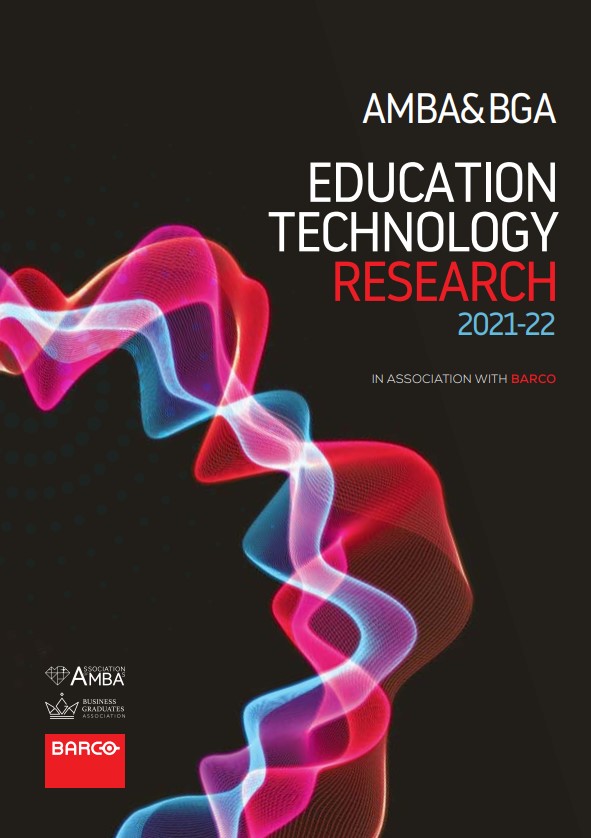Education technology (edtech) in business education is gaining momentum and shows no signs of slowing down.
Three quarters (75%) of Business School leaders say that their Schools are now using virtual classrooms – an increase from 51% at the end of 2020, according to the AMBA & BGA Education Technology Report, in association with Barco.
This report, based on a survey of 171 Business School leaders worldwide, tells the story of edtech in 2020 and 2021. In so doing, it reveals how Business Schools turned a crisis into an opportunity.
Following a year in which Business Schools were pushed into enhancing their investments in edtech by the Covid-19 pandemic and associated restrictions, 84% of participants to this survey have indicated that they want their Business School to retain the new technology that has been introduced.
Business School leaders have shown their Schools to have been both pragmatic and agile in the face of 2020’s disruption, according to the AMBA & BGA Education Technology Research, in association with Barco.
The 216 decision makers at international Business Schools who completed AMBA & BGA’s research demonstrated that while, initially, they have all been reactive to the need for to adopt tech rapidly in the face of social distancing; they also ascertained challenges quickly and moved to address them with innovative strategies and problem solving moving forward.
Responding Business School leaders are also keen to keep aspects of faculty teaching online (62%) and students not coming to campus (65%), suggesting that their preference for the future is hybrid or blended models of learning.
Indeed, most Business School leaders believe that the pandemic has triggered major changes to their institution’s long-term strategy and 82% are planning to invest further in technology over the coming two years to enable online teaching
Key findings
Format of teaching
- 75% of respondents said their Business School uses a virtual classroom, an increase from 51% last year.
- 25% of responding Business leaders said that their institution is using virtual reality (VR) to teach programmes, while 61% of participants said their School is not using this technology (14% were unsure). The majority (65%) of participants indicate that this technology is being used to teach in a more exciting way.
Synchronous vs. asynchronous learning
- The biggest advantage of both synchronous and asynchronous digital teaching methods is seen by participants to be less travel for students, as cited by 74% of participants.
- 54% expressed their belief that asynchronous digital teaching methods offer a worse experience for learners than classroom teaching. A smaller proportion, of 38%, said they believe synchronous digital teaching methods are inferior to classroom methods, in terms of learning experience.
- Whether online instruction is asynchronous or synchronous, the biggest problem experienced by Business Schools is identifying gaps in students’ knowledge (as reported by 69% and 55% of respondents, respectively).
- Lack of student engagement (64%); student connection issues (54%) and adapting programmes to suit online teaching formats (53%) are the most frequently cited challenges faced by Business School leaders when delivering online education in a synchronous format.
- 93% of respondents said they believe that facilitators/faculty are either ‘very satisfied’ or ‘fairly satisfied’ with the current synchronous digital teaching technologies.
Impact of Covid-19
- 84% of participants said they want their Business School to retain the technology that has been implemented during the pandemic – 16% want to keep aspects of it, but none want this technology discarded altogether.
- Responding Business School leaders are also keen to keep aspects of ‘faculty teaching online’ (62%) and ‘students not coming to campus’ (65%), suggesting that their preference for the future is hybrid or blended models of learning.
- 83% of Business School leaders said they believe that the pandemic has triggered major changes to their institution’s long-term strategy, while 17% said they believe that it has not.
Investment
- The MBA is the programme which is receiving the most funding for digital teaching methods – 83% of participants said that their Business School is investing a moderate amount or more in this programme in this way.
- Providing ‘flexibility in learning’ is the most popular purpose of existing investment in relation to online learning technologies, as cited by 77% of Business School leaders.
- ‘Flexibility in learning’ is also top of Schools’ minds when looking ahead to the next two years, for which it is cited as a priority for investment by 67% of respondents. Other top priorities include the enhancement of soft skills (cited by 57%) and student engagement metrics (45%).
- 82% of Business School leaders said their School is planning to invest further in technology over the coming two years to enable online teaching.





























